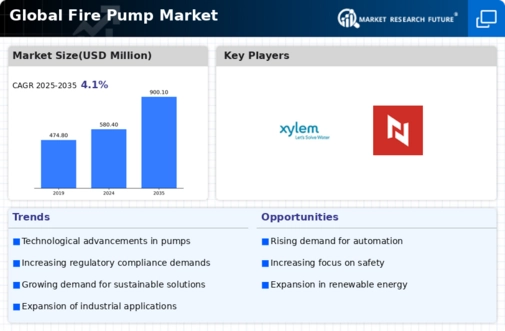Top Industry Leaders in the Fire Pump Market

*Disclaimer: List of key companies in no particular order
Top listed global companies in the Fire Pump industry are:
AMT Pump Company by Gorman-Rupp Company, Armstrong Fluid Technology, C.R.I. Pumps Private Limited, Canariis Corporation, Cet Fire Pumps MFG Inc., Eaton Corporation PLC, Firefly Fire Pumps Pvt. Ltd., Grundfos Pumps Corporation, IDEX Corporation, Johnson Controls International PLC, LUBI Industries LLP, NAFFCO Group, Peerless Pump Company, Pentair PLC, Rosenbauer International AG, Shanghai East Pump (Group) Co., Ltd, Shanghai Liancheng (Group) Co., Ltd., Shanghai Pacific Pump Manufacture (Group) Co.Ltd, Sintech Precision Products Ltd., SPP Pumps, Inc., Sulzer Ltd., Talco Fire Systems, Tech Mech Engineering Company, Teral-Aerotech Fans Pvt. Ltd., W. S. Darley & Co., Waterax, Waterous Engine Works Co. Ltd., and Xylem Inc.
Bridging the Gap by Exploring the Competitive Landscape of the Fire Pump Top Players
The fire pump market boasts a dynamic and vibrant landscape, where a diverse mix of established players and innovative newcomers clash for market share. To survive and thrive, companies must adopt strategic approaches and capitalize on emerging trends. This comprehensive analysis dissects the key player strategies, market share analysis factors, and innovative trends shaping the competitive scenario.
Key Player Strategies:
Product Domination: Leaders like Xylem and Grundfos leverage extensive product portfolios catering to diverse application segments. They offer horizontal split case, vertical turbine, and end suction pumps, catering to industrial, commercial, and residential needs.
Technological Excellence: Innovation is paramount, with players like Ebara and Flowserve investing heavily in R&D. They prioritize energy-efficient models, smart pump monitoring systems, and advanced materials for enhanced performance and reliability.
Regional Expansion: Geographic diversification is crucial. Pentair and Wilo are actively expanding into emerging markets like Asia-Pacific and South America, capitalizing on the construction boom and rising safety regulations.
Strategic Partnerships and Acquisitions: Collaboration is key. Companies like IDEX and Shanghai Kaiquan are forming partnerships with local players to strengthen distribution networks and gain market access. Additionally, acquisitions like Xylem's purchase of ITT further consolidate market positions.
Sustainability Focus: Environmental consciousness is gaining traction. Grundfos and Sulzer are promoting energy-efficient electric pumps and adopting sustainable manufacturing practices to cater to environmentally conscious customers.
Factors for Market Share Analysis:
Product Portfolio Depth and Breadth: Offering a diverse range of pumps for various applications, power sources, and capacities increases market reach.
Brand Reputation and Reliability: Established brands like Grundfos and Ebara command trust due to their proven track record and commitment to quality.
Geographical Footprint and Distribution Network: Extensive presence in key regions and robust distribution channels ensure prompt delivery and after-sales service.
Technological Advancements and Innovation: Companies with cutting-edge pump technologies and smart features attract both public and private sector clients.
Pricing Strategies and Customer Service: Competitive pricing strategies coupled with excellent customer service can build loyalty and win over competitors.
New and Emerging Trends:
Smart Fire Pump Systems: Integration of IoT and AI into pump systems enables real-time monitoring, predictive maintenance, and remote diagnostics, reducing downtime and maintenance costs.
Focus on Sustainable Solutions: Increased demand for energy-efficient electric pumps and adoption of recycled materials in production processes aligns with environmental regulations and customer preferences.
Modular Pump Design: Flexible and adaptable pump designs allow for easier customization and cost-effective retrofitting in existing fire protection systems.
Focus on Off-grid Applications: Solar-powered pumps are gaining traction in remote areas with limited access to electricity, ensuring fire protection without relying on traditional grids.
Subscription-based Maintenance Models: Companies are shifting towards offering pay-per-use or preventive maintenance contracts, providing predictable costs and ensuring optimal pump performance.
Overall Competitive Scenario:
The fire pump market is characterized by intense competition, with both established players and emerging startups vying for market share. Success hinges on understanding evolving customer needs, embracing technological advancements, and adopting strategic approaches like targeted regional expansion, sustainable practices, and smart pump solutions. Companies that adapt to these trends and demonstrate agility in their strategies will be best positioned to navigate the dynamic competitive landscape and secure their place in the fire pump market.
Latest Company Updates:
Armstrong Fluid Technology:
- December 2023: Announced partnership with Johnson Controls for integrated building automation and fire pump control systems. (Source: Armstrong Fluid Technology press release)
C.R.I. Pumps Private Limited:
- January 2024: Introduced a new range of vertical turbine fire pumps with enhanced durability and reliability. (Source: C.R.I. Pumps website)
Canariis Corporation:
- November 2023: Received UL listing for its new line of electric fire pumps, expanding market reach. (Source: Canariis Corporation press release)
Cet Fire Pumps MFG Inc.:
- September 2023: Awarded a major contract to supply fire pumps for a high-rise development project in Dubai. (Source: Cet Fire Pumps website)
Eaton Corporation PLC:
- October 2023: Collaborated with Grundfos to develop a joint fire pump offering combining their expertise. (Source: Eaton Corporation press release)

